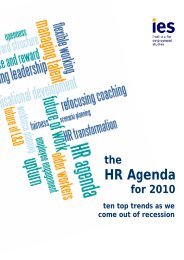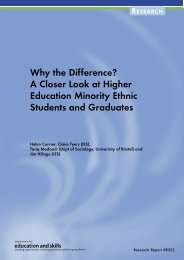Post-16 Transitions: a Longitudinal Study of Young People with ...
Post-16 Transitions: a Longitudinal Study of Young People with ...
Post-16 Transitions: a Longitudinal Study of Young People with ...
Create successful ePaper yourself
Turn your PDF publications into a flip-book with our unique Google optimized e-Paper software.
8.2 Friends and other relationships<br />
Almost all young people in the survey said that they had at<br />
least two good friends <strong>with</strong> just four per cent <strong>of</strong> the sample<br />
reporting that they had no good friends at all (Figure 8:1).<br />
Over half <strong>of</strong> all young people said that they had six or more<br />
good friends. The incidence <strong>of</strong> statementing, the type <strong>of</strong> school<br />
attended or the type <strong>of</strong> special educational need does not<br />
appear to have any bearing on the friendships <strong>of</strong> young people<br />
as all recorded similar numbers <strong>of</strong> friends.<br />
Two-thirds <strong>of</strong> young people participating in the survey stated<br />
that they had had a boyfriend, girlfriend or partner at some<br />
point since completing Year 11. However, young people who<br />
had been statemented at school and/or who had attended a<br />
special school were much less likely to say that they had had a<br />
partner over the same time period when compared to their<br />
counterparts <strong>with</strong>out statements or those who had attended a<br />
mainstream school.<br />
Most young people also reported that none or only a few <strong>of</strong><br />
their friends had any disabilities or difficulties (83 per cent).<br />
However, just over one in ten <strong>of</strong> all young people stated that<br />
most <strong>of</strong> their friends had disabilities or difficulties <strong>of</strong> some<br />
sort. This was particularly the case for young people who had<br />
statements <strong>of</strong> SEN at school (23 per cent <strong>of</strong> whom reported<br />
that most <strong>of</strong> their friends had disabilities or difficulties<br />
compared to just two per cent <strong>of</strong> young people <strong>with</strong>out<br />
statements). Similarly, young people from special schools<br />
were very much more likely to report that most <strong>of</strong> their friends<br />
had disabilities or difficulties (42 per cent versus just two per<br />
Figure 8:1: Number <strong>of</strong> good friends<br />
More than 10<br />
22%<br />
Don't know<br />
1%<br />
(None)<br />
4%<br />
1<br />
7%<br />
N = 1,874<br />
6-10<br />
23%<br />
2-5<br />
43%<br />
Source: IES/MORI 2003<br />
120<br />
<strong>Post</strong>-<strong>16</strong> <strong>Transitions</strong> <strong>of</strong> <strong>Young</strong> <strong>People</strong> <strong>with</strong> SEN: Wave 2

















